Franklin Academy: Built 1849-50, Closed 1910
.......................Franklin Central School: Built 1910, Closed 1992
.......................Franklin Elementary School: Built 1992
Franklin Academy**The first high school was an academy, a brick building comfortably situated.
.
.
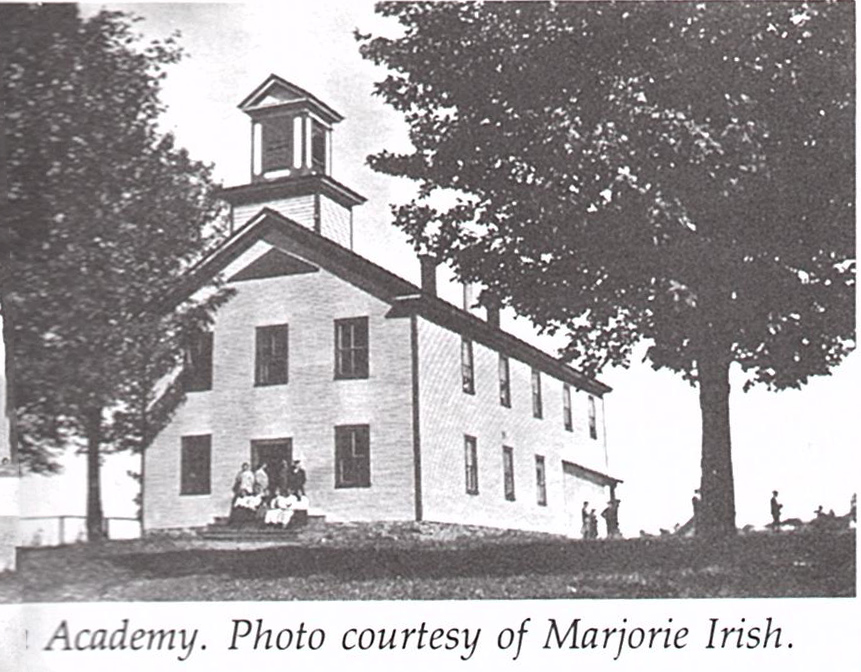 Later a wooden school building was built on the park by the Congregational Church. Franklin Academy was incorporated in 1849 and went into successful operation the next year with Mr. Smith as the first preceptor. Some of the principals following him were ex-Governor Roswell Farnham, Professor A.M. Butler, Miss M.A. Pomeroy, and Charles W. Gates. This school was very popular for a while. When the academy started there were, besides the principal and his assistant, four teachers, one of French, two of music, one teaching piano, and piano and seraphine, which was an early keyboard reed instrument of which the melodeon is a portable variety. There was also a teacher of painting and drawing.
Later a wooden school building was built on the park by the Congregational Church. Franklin Academy was incorporated in 1849 and went into successful operation the next year with Mr. Smith as the first preceptor. Some of the principals following him were ex-Governor Roswell Farnham, Professor A.M. Butler, Miss M.A. Pomeroy, and Charles W. Gates. This school was very popular for a while. When the academy started there were, besides the principal and his assistant, four teachers, one of French, two of music, one teaching piano, and piano and seraphine, which was an early keyboard reed instrument of which the melodeon is a portable variety. There was also a teacher of painting and drawing.
The total enrollment for the first year was one hundred ninety pupils. Of these sixty per cent were from out-of-town. They came in great numbers from Franklin County, from other counties, and a few from other states.
Some of the subjects taught then which are no longer offered were: mental philosophy, botany, geology, surveying, Greek, and later, German.
There were two literary societies, the Debating Society in charge of the principal, and the Literary Association which had weekly lectures.
Tuition was charged for each subject. Board could be had at $1.25 a week, and rooms at reasonable rates.
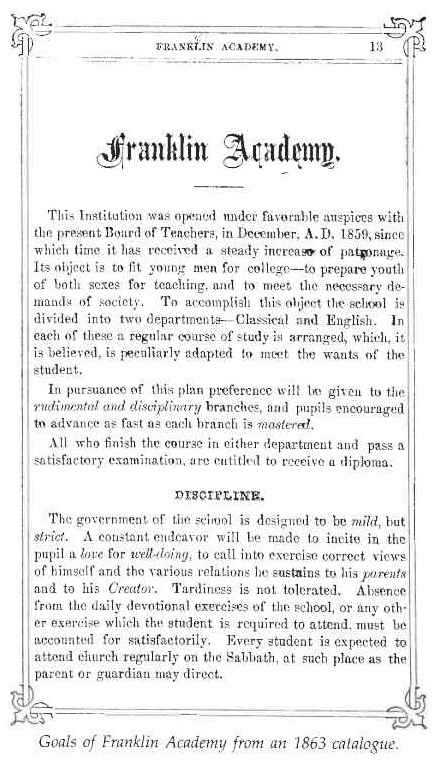
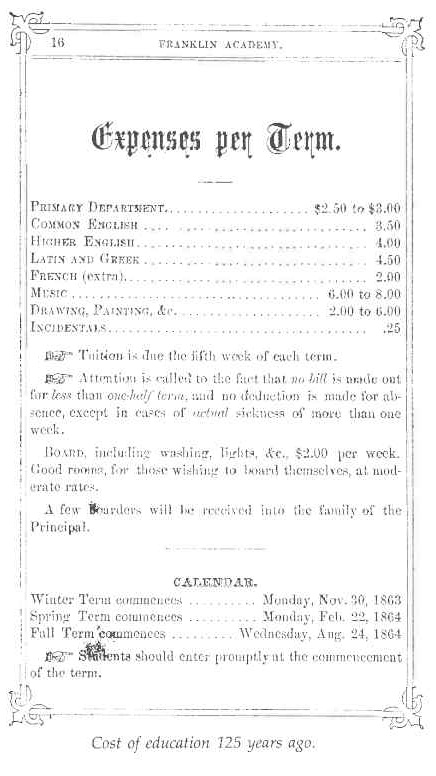
The regulations were somewhat more strict than they are now. The principal had full authority over the students. No student was permitted to leave town during term time. They could leave their rooms during study hours by permission of the principal, but they were expected to stay in their rooms otherwise. This brings to mind a little episode.
Principal Charles Gates used to practice calling around after 8 o’clock in the evening to see if his orders were obeyed. One evening when Herbert Comings happened to be visiting two young ladies, Mr. Gates’ step was heard on the stairs. The girls immediately hid Herbert in the closet. Mr. Gates’ call was short and Herbert soon emerged from the closet, supposing that he was undiscovered. The next morning after scripture and prayers, Mr. Gates ordered Herbert Comings to stand up. Mr. Gates then proceeded to ask him, in front of the school, why, on the occasion of his visit to the two young ladies had Herbert hidden in the closet and neglected to take his hat. This, of course, greatly embarrassed him and Mr. Comings says that never again did he leave his hat around.
However, I find that another young man, Schyler Hammond, by name, was more fortunate. As Mr. Gates was heard coming up the long hall, Schyler dashed for the closet and Mr. Gates came into the room to find three young ladies very busily getting their spelling lessons. In the meanwhile, Schyler had settled himself on a very squeaky trunk in the closet, but the girls helped him out. The louder the trunk squeaked, the louder the spelling words were pronounced and Mr. Gates went away unsuspecting. It makes one wonder what they would have done without closets in those days.
During the same period, the schools had weekly rhetoricals. At one of these, my grandfather, Charles Dewing, was to give a speech on education. Because he was a young man of few words, everybody sat back in their seats and wondered what was coming.
He arose and proceeded: “Education. Education’s hard to get. I've said a few words, and that’s harder yet.”
Another regulation of the school was that the students should go to church on the Sabbath; and I hear that a principal amusement of the young gentlemen was to go to church and walk home with the girls.
At first there were four terms in a school year, but later, three terms. The boys would go during the terms when they had the least farm work to do. During the fall and spring terms a Teachers’ Class was formed for those who intended to teach in the winter or summer.
The academy was not divided into classes, but one went until he thought he had had enough education; then, if he wished, he could take a teacher’s test and teach on a permit.
Public examinations were held at the close of the fall and spring terms, to which patrons and friends of the school were cordially invited. As for recitations, the motto was, “Be thorough instead of rapidly “getting through the book.”
By 1899 our academy was called a high school and housed the grades also. At this time graduation was held; tuition was paid only by those living outside of town; the high school curriculum included the Latin-scientific course, the English course, and the Teachers’ course. The total number of pupils in the high school was twenty-nine. Entrance examinations were required. The aim of the school was to prepare its pupils for entrance to college, for teaching, or for life itself.
There was much controversy over a new school building. Many people voted against the new building because it would cost too much, and people looked out for themselves first. Finally, our present school was built. It was opened in 1910. The old academy was cut in two and part of it became the house in which Joe Bouchard now lives. There was no graduating class in 1910, but in 1911 the institution became an accredited high school.
Comparing the old academy with our high school today, we find that the enrollment has greatly decreased from one hundred ninety to thirty in our senior high school this last year, As for curriculum, not as much emphasis is placed on geography now. We have no art or piano lessons. Greek and German are no longer taught. We have graduation; in order to teach school a college education is required. We no longer go to school in the summer. Schools are now supported by taxation, and only those from outside of town pay tuition. We buy our own books, instead of renting them from the school.
Several illustrious people have come from our school. Anna Powell Hacket, Wilma Powers Olephant, and Myron Powers have been foreign missionaries. Gordon Tittemore was the Principal of Burlington Business College for many years. George Foss was the father of a congressman from Chicago and a governor of Massachusetts. Several have had important government positions in Washington. There have been high ranking army officers, ministers, doctors, and a great number of teachers.
Among our principals there have also been important people. Our second principal, Roswell Farnham, was an ex-governor; Charles W. Gates later became our governor; and G. Leland Green was the first principal of the Vermont State School of Agriculture in Randolph and later president of an agricultural college in Rome, Georgia.
Occasionally there has been talk of giving up the school. One man protested because he had a large family and could not afford out-of-town tuition for all of his children. The school was kept and from his family there are two foreign missionaries and four teachers.
Note (1959): Again, the question of Franklin’s joining a central school is being debated, but the idea was soundly defeated in a spirited town meeting in 1938. However, the issue will doubtless recur, and must be met with determination if Franklin is to keep its own school.
M. Priscilla (Dewing) Gates 1946
1905—Franklin Military Academy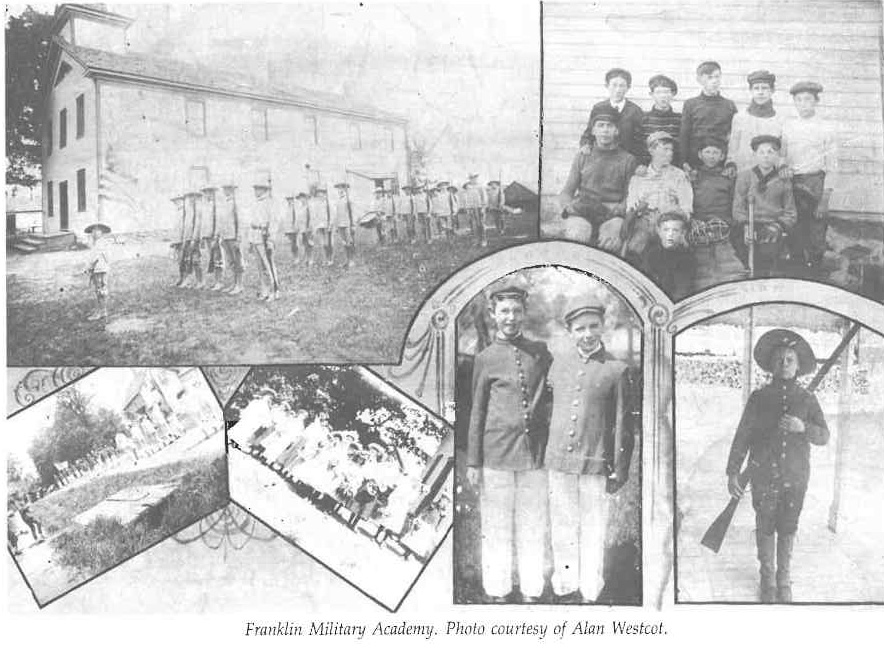
The site and fate of the old 1850 brick academy building, a private academy, has not been ascertained. An account of the school was featured in the 1968 Schedule of Events. The wooden academy, white with green trim, standing in the space between the Congregational Church and the Parsonage was the next school of higher learning and was a public school of four rooms, the high school homeroom and classroom upstairs, primary and grammar rooms downstairs. Each room was heated by a large, wood-burning stove encased in a heat jacket of zinc to protect the children and to increase heat circulation. In winter few, only if necessary, asked to leave the room for the Arctic regions below in the convenience rooms. Three or four round holes in a wide plank, each with a hinged wooden cover, made up the facilities, one room for boys, one for girls.
Three teachers sufficed for the high school with schedules for them overloaded as many subjects were taught; one teacher for the primary room—four grades, and one for the grammar room - the four upper grades. This was Town School District No. 1.
Athletics were not as stressed as they are today. There were basketball and baseball teams. Dumbbells and Indian Club drills were given in the Town Hall for both boys and girls. There was no athletic field. For a few years, while Mr. C. L. Jordan, a military-minded man, was principal, military drill held precedence over athletics. The school was then called a military academy. Boys wore uniforms and drilled with guns according to the West Point Manual of Arms. At the end of the school year, the Cadets enjoyed ten days of camping on the shores of Silver Lake. The girls were allowed to visit in the daytime.
Franklin Historical Society
M.T.
What Was Done With the Old Schoolhouse Used Until 1911?
The very old schoolhouse, which stood on the land that is now called Marsh Park and the Veterans Memorial Picnic Area, was taken down in two parts. One part was sold to Charles Ladd which he attached to the house he built, which is now the home of Aline Bouchard. The other part was moved down behind the Bouchard house and set up and finished off for an apartment house. The first occupants were Raymond and Bernice Streeter. Doris Mullen and her brother, Kenneth, lived there when I went to high school. Later Doris Mullen married Joseph Belanger and they lived there, then moved to St. Albans.
Bernie Ploof and his wife, Beatrice Tatro Ploof, lived there awhile. Now the house is gone, cellar stones and wall are still there, far down behind the home of Marjorie Gates Irish and Robert Irish.
Franklin Central School**The present (1989) elementary school building was ready for occupancy in 1910 or 1911. Franklin High School was in that building as were the first nine grades. Ninth grade was dropped in about 1920 from the Vermont curriculum. In 1970 those who were entering grades 7 through 12 were bused to Missisquoi Valley Union High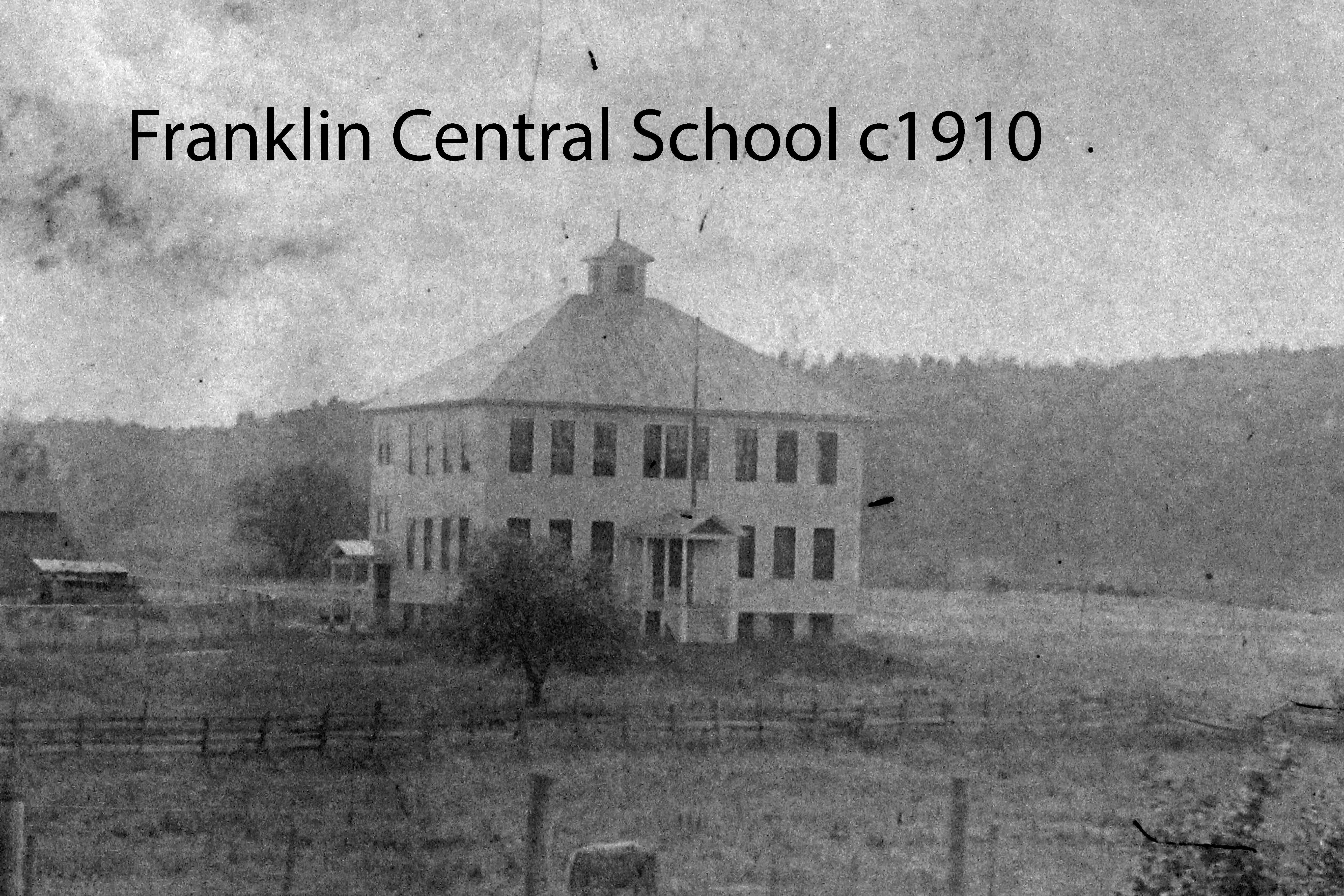 School #7.
School #7.
Our old school building housed grades 1 through grade 6. In the fall of 1986, a public kindergarten was added to the student body of Franklin Elementary School.
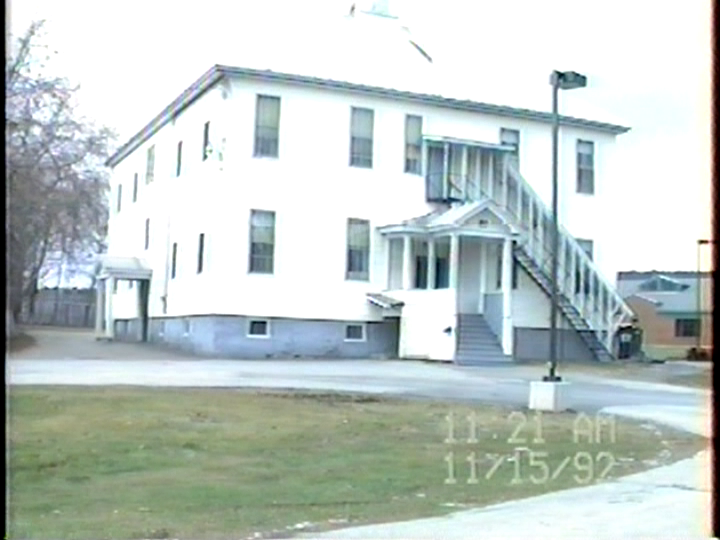 .
.
.
.
.
.
The 1910 Franklin Central School building was torn down in 1992 when the new Franklin Elementary School was opened. An addition was recently added to accommodate the increased student numbers due to additional state-mandated programs.
The Old School Bell: A Franklin Tradition
From late August to mid-June, Monday through Friday, a familiar sound can be heard in the Village of Franklin, th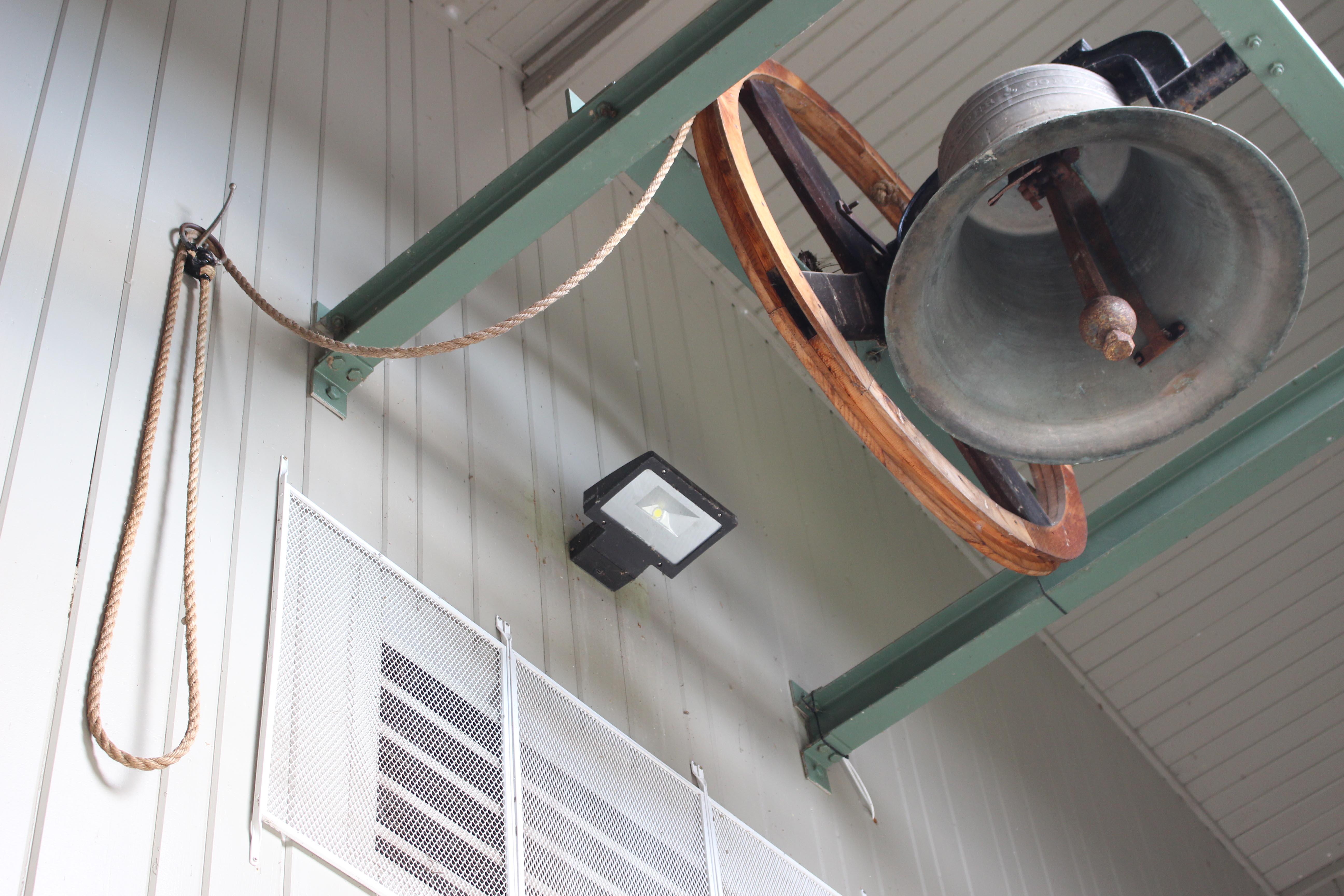 e pealing of the Central School bell. Schools, and the education they provide for our children, have always been an important priority for the people of Franklin.
e pealing of the Central School bell. Schools, and the education they provide for our children, have always been an important priority for the people of Franklin.
The raised lettering on the bell reads:
“CAST BY HENRY N HOOPER & COMPANY BOSTON 1850”.
The bell first hung atop the Franklin Academy which was built in 1849-50. The Academy was located on the land which is now Marsh Park in Franklin Village.
It was moved to the newly built Franklin Central School in 1910.
The bell was once again moved, this time to the new Franklin Central School in 1992.
In 2006 the bell was removed briefly for repairs. The wooden wheel for the rope had deteriorated, and the sixth-grade class decided that their class gift would be the necessary repairs. So, a new wheel was made by Donald Rainville. While the bell was down, the Franklin Volunteer Firemen cleaned it, Charbonneau’s Body Shop clear coated it, and then the Franklin Fire Department reinstalled it.
The bell is rung each morning by the students. Everyone gets a chance to ring it, just like their parents and grandparents before them. Ringing the Franklin Central School Bell is definitely a Franklin tradition. (Thank you to Stacey Boudreau and Principal Joyce Hakey for the information for this article.)
Update: In 2023 the bell was once again removed while the new addition to the school was built. The bell has now been placed in a new bell tower on the front of the new addition.